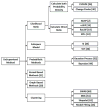A Survey of Methods for Time Series Change Point Detection
- PMID: 28603327
- PMCID: PMC5464762
- DOI: 10.1007/s10115-016-0987-z
A Survey of Methods for Time Series Change Point Detection
Abstract
Change points are abrupt variations in time series data. Such abrupt changes may represent transitions that occur between states. Detection of change points is useful in modelling and prediction of time series and is found in application areas such as medical condition monitoring, climate change detection, speech and image analysis, and human activity analysis. This survey article enumerates, categorizes, and compares many of the methods that have been proposed to detect change points in time series. The methods examined include both supervised and unsupervised algorithms that have been introduced and evaluated. We introduce several criteria to compare the algorithms. Finally, we present some grand challenges for the community to consider.
Keywords: Change point detection; Data mining; Machine learning; Segmentation; Time series data.
Figures





References
-
- Montanez GD, Amizadeh S, Laptev N. Inertial Hidden Markov Models: Modeling Change in Multivariate Time Series. AAAI Conference on Artificial Intelligence. 2015:1819–1825.
-
- Kawahara Y, Sugiyama M. Sequential Change-Point Detection Based on Direct Density-Ratio Estimation. SIAM International Conference on Data Mining. 2009:389–400.
-
- Boettcher M. Contrast and change mining. Wiley Interdiscip Rev Data Min Knowl Discov. 2011 May;1(3):215–230.
-
- Hido S, Idé T, Kashima H, Kubo H, Matsuzawa H. Unsupervised Change Analysis using Supervised Learning. Adv Knowl Discov Data Min. 2008;5012:148–159.
-
- Scholz M, Klinkenberg R. Boosting classifiers for drifting concepts. Intell Data Anal. 2007;11(1):3–28.
Grants and funding
LinkOut - more resources
Full Text Sources
Other Literature Sources
